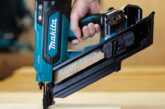
 Next up in our series of buyers’ guides for tools, Makita offers some tips on choosing the right auto-feed screwdriver.
Next up in our series of buyers’ guides for tools, Makita offers some tips on choosing the right auto-feed screwdriver.
For any professional taking on roofing, loft and insulation upgrades, an auto-feed screwdriver is a valuable addition to their kit. Utilising collated, belt-fed screws, an auto-feed screwdriver is ideal for repetitive fixing and rapid screw driving tasks. This includes fixing down a timber deck for a flat roof or installing the plywood or OSB base for sheet roofing material. It is also a useful tool to have to hand when boarding-out lofts, or for a range of tasks involved in loft conversion projects, including studwork, drywall and flooring installation.
An auto-feed screwdriver has benefits beyond the obvious speed and precision it offers. With the screw held and driven directly from the tool, it leaves one of the user’s hands free to hold the material in place, making for easy work whilst ensuring that every screw can be driven to the exact required depth every time. This ease of operation is increased further by selecting a cordless tool, as this eliminates the restrictions, inconvenience and safety risks of power cables in the work area – especially relevant when working at height.
In addition to choosing a cordless machine, there are also other important factors that must be considered to ensure the right product is selected.
Compatibility with other tools
By its nature, an auto-feed screwdriver will not be used for every task but is a part of the kit that can be called on where there is a need to streamline the fixing of a large number of screws across a large area. Therefore, it is an advantage to invest in an auto-feed screwdriver that shares a battery platform with many other tools to make it easy to switch quickly between machines as required. Choosing one that shares a battery platform with the combi drills, impact drivers, circular saws, reciprocating saws, nailers and angle grinders used every day is a clear advantage. For example, the Makita 18V LXT battery platform includes more than 290 compatible products.
Easy configuration
Getting the best performance from any auto-feed screwdriver requires it to be configured correctly for the job at hand. The drive shaft fitted in the tool must of course be the right one for the type of screws used, such as Philips, Pozidrive or Square head screws. A machine with a simple and easy mechanism for replacing the screwdriver bit will help make this process as quick as possible. It is worth looking for one with a tool-less removal of the auto-feed carriage or even one with a quick-release mechanism, such as the Makita DFR551 Auto Feed Screwdriver. Similarly, it is essential that the tool allows easy and clear setting of the carriage based on the length of the screw.
Control
Another important consideration is the level of control the tool provides. For example, when working with certain materials, a machine with variable speed control can help ensure the screw is driven smoothly and accurately into the material. An easy-to-use reverse function is also a benefit if a screw needs to be removed or repositioned.
It may also be worth looking for an auto-feed screwdriver that can vary the depth of the screw into the material. For example, the Makita DFR551 features a wheel control on the side of the carriage that allows the user to choose whether the screws are driven flush with the work piece or countersunk into the material to the required depth.

Efficiency
Features for improved efficiency and ease of use are also valuable. Tools that include brushless motors can help improve productivity by increasing run times by up to 50% per battery charge. Motors with brushes rely on contact between carbon brushes and a rotary electrical switch on the rotor to drive the tool. This causes friction that generates heat and wastes energy. Brushless motors eliminate this by using contact-free electromagnetism to drive the tool.
When carrying out the repetitive fixing tasks for which auto-feed screwdrivers excel, it is useful to have a tool with a degree of automatic functionality. Some auto-feed screwdrivers have a lock-on function that allows the carriage to be simply pressed against the material to drive the screw. However, these often require the tool to be running continually and wasting a significant amount of battery power and creating a sustained level of noise as a result. The alternative to this is the Push Drive Technology that is included on the Makita DFR551. When Push Drive is activated, the motor will run automatically but only when the screw is pressed against the workpiece to reduce the risk of stripping the head of the fixings. This also reduces power consumption and extends battery run times, as well as minimising noise.

An auto-feed screwdriver can be a useful part of the kit of any professional that regularly takes on roofing work and is also valuable for flooring, studwork, drywall and even garden decking installations. Choosing the machine with the right features and functionality will help to maximise the benefit of this investment.
To find out more about Makita’s range of 18V LXT tools visit www.makitauk.com.









